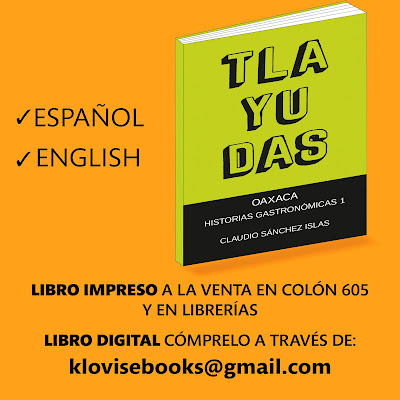The tlayuda dish has a history that was not known. With this publication printed in full color, illustrated with interesting photos, published in English and Spanish and available in an ebook version, it is now possible to have that information.
For the first time, an editorial effort is made to approach gastronomy from history itself, with sources and documents. It is not folklore or mythology, but an academic essay. The author is Claudio Sánchez, a graduate of the Claustro de Sor Juana University, professor of Kitchen History at the UABJO School of Gastronomy, as well as his famous Humanities Research Institute, IIH.
The printed book is for sale in bookstores in the City of Oaxaca, but if you live outside of it and require it, please contact klovisebooks@gmail.com
Also if you request the book in digital version, go to that email to find out the mechanism for payment and receipt of the book file.
CONTENTS
-THE CORN TORTILLA, A NECESSARY TYPOLOGY
-THE NATURAL TORTILLA TLAYUDA AS “ITACATE”, OR PEASANT'S LUNCH
-THE “CAMPESINA”-PEASANT–TLAYUDA, SNACK FOR TRAVELERS AND PILGRIMS
-ORIGIN OF THE CHINA OAXAQUEÑA, AN EMBLEMATIC WOMAN COOK
-TLAYUDAS: “OPEN” AND “FOLDED” FEATURES
-THE ESSENTIAL INGREDIENTS
-HISTORICAL DATA OF THE TWO TYPES OF TLAYUDAS
-TLAYUDA TORTILLA IN 1713, AT THE FIRST GASTRONOMIC FESTIVAL EVER
-THE TLAYUDA UNDER THE FRENCHIFIED MODEL IN THE 19TH CENTURY
-CLAYUDAS WITH A “ASIENTO” FOR PRESIDENT PORFIRIO DÍAZ
-TLAYUDA IN THE 21ST CENTURY, THE TRANSITION TO A GASTRONOMIC DISH
-WHERE TO EAT THE AUTHENTIC PEASANT TLAYUDA NEXT TO ZAPOTEC PEASANTS?
-VEGAN “ASIENTO”
-FAST FOOD OR JUNK FOOD?
-LOOKING FOR THE CORRECT ETYMOLOGY: TLAYUDA OR CLAYUDA?
-THE CLAYUDA ACCORDING TO THE EARS OF LINGUISTS
-AND HOW DO YOU SAY TLAYUDA IN ZAPOTEC LANGUAGE?
-SCHEME OF THE CORN TORTILLA TO GASTRONOMIC DISH



